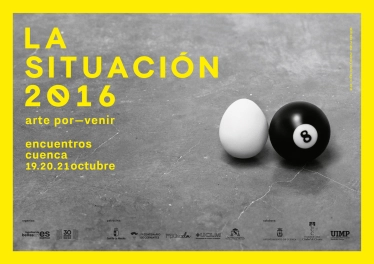Arte por-venir. Encuentros Cuenca. 18-21 de octubre 2016

Encuentro internacional que tuvo lugar en Cuenca, España, del 18 al 21 de octubre de 2016 para debatir sobre el estado actual de las prácticas artísticas en el ámbito iberoamericano. Toma su nombre del encuentro de ámbito estatal que tuvo lugar también en Cuenca en abril de 1993, en el contexto de la crisis que afectó a la economía, la sociedad y la cultura a principios de los noventa.
Participaron, entre otros, Isidoro Valcárcel Medina, Luis Camnitzer, María Ruido, Rogelio López Cuenca, María Cañas, Wilfredo Prieto, Mujeres Creando, Dionisio Cañas, Nicolás Paris, la Internacional Errorista, Daniela Ortiz, Rolf Abderhalden, Juan Domínguez, Federico Guzmán, Sally Gutiérrez, Glenda León, Roberto de la Torre, Manuela Zechner, Terrorismo de Autor, Daniel Miracle, Somos Nosotros, Colectivo Out-ziders, Ni arte ni educación, Miguel Ángel Rego, Aïda Gómez, Jordi Ferreiro, Anja Schneider, Rubén Marín, Andrés Senra, Anna Katarina Martín, Mariano Orte…
La Situación 2016 fue un foro de debate, que se realizó como una serie de plenarios y mesas, pero que también tendrá forma de talleres, proyecciones de vídeo, intervenciones, conferencias performativas, muestras de materiales y documentos, presentaciones de proyectos, conciertos, acciones e intervenciones en la Facultad de Bellas Artes, la Iglesia de san Miguel, la Casa de la Demandadera y otros espacios de la Ciudad de Cuenca.
“Lo que habitualmente entendemos por práctica artística es un tipo de producción y experiencia que sigue siendo en gran parte dependiente de la idea de “bienestar social”. En la época de mayor vigencia del mito de la “sociedad del bienestar”, los artistas llegaron a pensar una generalización de la práctica artística a todos los ciudadanos. Pero ¿cómo se posicionan los artistas tras el derrumbamiento de ese mito? ¿Qué ocurre cuando el “bienestar” ya no sólo no es una realidad, sino ni siquiera un horizonte? ¿Y qué hacer en relación a los excluidos? ¿Qué hacer si los propios artistas comienzan a ser también excluidos? […] Las prácticas artísticas manifiestan las consecuencias de estos violentos ajustes, dan cuenta de ellos sismográficamente, pero también pueden intervenir en ese espacio de tensión, produciendo lugares de exprimen.”
Un proyecto realizado por estudiantes y profesores de la Facultad de Bellas Artes de Cuenca / UCLM.